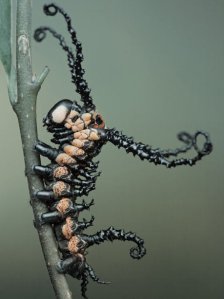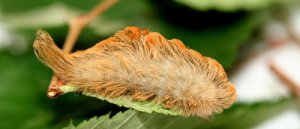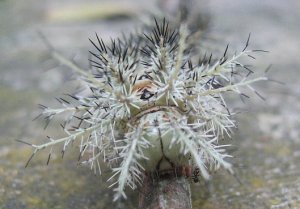

The insect world is rife with critters that are both terrifying and awesome. Unfortunately, because of their size, they often go unnoticed. So take a moment out of your day to rectify this problem. Get to know some of the world’s most remarkable, tiny inhabitants.
The Brahmin caterpillar moth:

Imagine a scenario where a scary Tim Burton movie came true. Suddenly, the things in your scariest dreams are spontaneously generating on Earth. There are beasts running about, and skeleton-white creatures singing in the rain, and look, now it is raining hair–It seems like the brahmin catepillar was born from such a scenario.
Although they are not harmful to you in any way, they look like terrors that were sent to plague the rest of the animal kingdom. Just have look at this thing! From the wackadoo head headgear to the black and pointed tail, it seems that they were geared for destruction. In reality, they are just kindly caterpillars; they do little more than eat and metamorphose into beautiful looking moths.
From the family of insects called Brahmaidae, it’s hard to imagine why such a bizarre looking thing exists, or what possible reason it has to look like this in its caterpillar stage. Some believe that the spindles on their heads help them blend in with the twigs and small branches found of foliage. Certainly, when they are moths, they are perfectly camouflaged for trees. Also, once they turn into moths, they have a wingspan that can reach up to 20cm (just over 7 inches).
The Puss Caterpillar:

What could be more vile sounding than a name like “the puss caterpillar”? Well, add to that a venomous, creepy crawling ball of fur and you have quite the combination. This caterpillar is camouflaged to perfectly fit in your home –like on that vintage shaggy rug in your living room. And this little creature packs a nasty surprise. You see, caterpillars are high in protein and are slow moving; they make easy prey items for a multitude of creatures. So they required some form of defense mechanism. Unsurprisingly, they toxic ones were best suited to survive and thrive. So the puss caterpillar will be unpleasant if ingested, and they are also venomous if stepped on. They sound like a tiny ball of fun, no?
Also called Megalopyge opercularis, these stinging caterpillars have urticating hairs. These hairs are hollow bristles that break when tampered with or crushed, and in this case, once they are broken they release toxin from the glands below. These little guys can be found in the Southern U.S. and also in Mexico and Central America.
According to the American Association of Clinical Chemistry (AACC), the toxin symptoms are as follows: ” Intense throbbing pain develops within five minutes of contact, with pain extending up the affected arm. Other symptoms may include headaches, nausea, vomiting, intense abdominal distress, lymphadenopathy, lymphadenitis, and sometimes shock or respiratory stress.” That being said, regardless of how cool they look, they probably wouldn’t make the best pets.
Giant Silkworm Moth:

Last on our list s a widely studied caterpillar formally called Lonomia obliqua, or the Giant Silkworm Moth. Residing in South America, this caterpillar is responsible for several human deaths each year. Its urticating hairs are quite fragile, and release a potent toxin that is poisonous when ingested. Like the previous caterpillar, it can also envenom subjects if they are penetrated via the spines that are covering its entire body.
According to research published in the journal Toxicon, “the Lonomia obliqua has a unique venom that causes disseminated intravascular coagulation and a consumptive coagulopathy, which can lead of hemorrhagic syndrome.” Grangrene-like symptoms can emerge throughout the body, eventually causing massive blood leakage into the brain, and in several cases, death.
In short, you will die because you will bleed and won’t be able to stop due to strong anti-clotting agents. There have been at least 500 confirmed deaths so far. This horrifying quality has also lead it to being the most studied caterpillar in the world in the medical field (for its anti-blood clotting properties in its toxin).